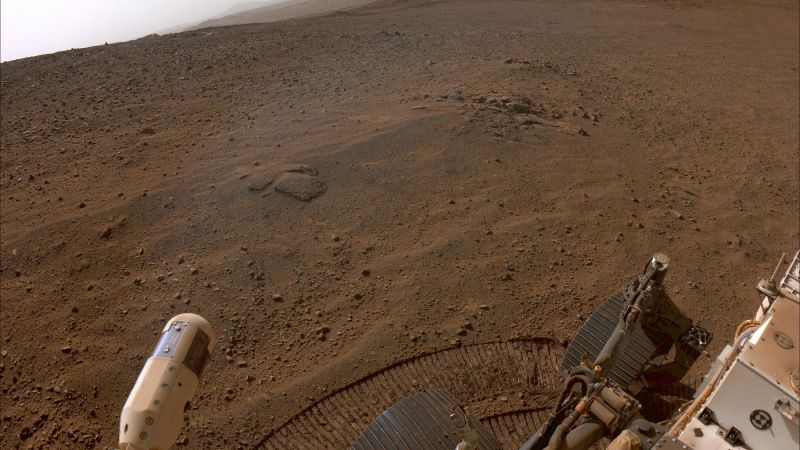After an extensive and challenging journey spanning several months, NASA’s Perseverance rover has successfully reached the summit of Jezero Crater on Mars. This significant milestone marks the rover’s continued exploration of a unique landscape that offers new scientific opportunities. Over the course of its 3 and a half years on the Martian surface, Perseverance has navigated a wide variety of terrains, but the top of Jezero Crater presents a region previously unexplored, brimming with geological mysteries.
With its arrival at this pivotal site, Perseverance is now set to investigate some of Mars’ oldest rocks. These ancient formations are of prime interest as they hold clues about the planet’s enigmatic past. Scientists hope to uncover whether ages gone by bore conditions suitable for life, as the rover embarks on a mission to collect samples that might reveal microfossil remnants. This search for signs of ancient Martian life underscores the rover’s primary goal of determining the planet’s potential for once harboring life.
Over the course of its approximately 3.5-month trek, the rover ascended a daunting altitude of around 1,640 vertical feet (500 meters), tackling steep slopes inclined at 20 degrees. The journey presented significant engineering challenges, given that the rover navigated some of the most treacherous terrain it had encountered since landing on Mars in February 2021. Fortunately, the adept team at NASA’s Jet Propulsion Laboratory (JPL) based in Pasadena, California, devised innovative solutions to ensure Perseverance’s safe ascent. As shared by Steven Lee, the project’s deputy manager, the team utilized various strategies, even experimenting with reverse driving maneuvers, and the rover emerged from this arduous journey in excellent condition.
In its current phase, the Perseverance rover has already conducted extensive investigations of Jezero Crater’s floor and the river delta, revealing insightful data accumulated from rock and dust sampling. Jezero Crater is particularly noteworthy as it was once the site of a vast lake approximately 3.7 billion years ago, suggesting a historical potential for life. After reaching the summit, Perseverance is shifting focus to its “Northern Rim” campaign, planning to traverse an additional 4 miles (6.4 kilometers) while collecting samples from multiple geological sites over the following year.
Project scientist Ken Farley from the California Institute of Technology noted the exciting implications of the upcoming research, emphasizing the scientific richness that the Northern Rim campaign promises as it transitions to investigating fundamentally new geology. These geological formations represent remnants of some of the oldest rocks identified in the solar system, critical for understanding Mars’ geographical history, as well as offering insights into the early conditions of Earth.
The rover’s immediate objective is to reach Witch Hazel Hill, a prominent rock outcrop situated about 1,500 feet (approximately 457 meters) down the opposite side of the crater rim. The geological layers at this site tell the story of Martian history, with each stratum acting like a page in a geological ledger. As Candice Bedford, a Perseverance scientist from Purdue University, mentioned, the investigation into these layers could provide a deeper understanding of the ancient environments that shaped Mars and potentially resemble past conditions on Earth.
Following this exploration, Perseverance will head towards Lac de Charmes, which lies in the plains beyond the crater rim. This area is deemed less likely to have been affected by the catastrophic impact that formed Jezero Crater, thus offering scientists a more intact geological record. This path will allow the rover to loop back to further examine ancient bedrock shards potentially dislodged by the major impact events of Martian history.
As the mission team gears up for these investigative efforts, they reflected on the rover’s ascent and noted some remarkable findings along the way. Among them is a zebra-striped rock, nicknamed Freya Castle, which poses intriguing questions regarding its formation. Another significant discovery was a field of brilliant white rocks identified as pure quartz, an indication of possible ancient hot spring environments—conditions intriguing because they suggest the potential for past life-sustaining habitats.
As Perseverance prepares to delve deeper into its geological studies, it hopes to study rocks that predate the formation of Jezero Crater itself, likely older than 4 billion years. Such investigations are particularly exciting for the scientific community, as understanding the solar system’s early history enhances our knowledge of rocky planet formation, especially since Earth lacks early geological records due to extensive erosion. Mars, therefore, stands as a crucial site for uncovering the mysteries of our solar system’s formative years.



